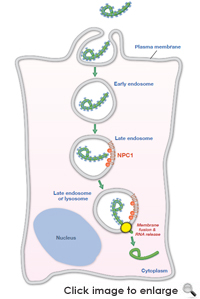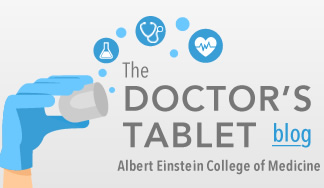
Ebola virus
Researchers Find "Key" Used by Ebola Virus to Unlock Cells and Spread Deadly Infection
August 24, 2011 — (Bronx, NY) — Researchers at Albert Einstein College of Medicine of Yeshiva University have helped identify a cellular protein that is critical for infection by the deadly Ebola virus. The findings, published in today's online edition of Nature, suggest a possible strategy for blocking infection due to Ebola virus, one of the world's most lethal viruses and a potential bioterrorism agent.
The study was a collaborative effort involving scientists from Einstein, the Whitehead Institute for Biomedical Research, Harvard Medical School, and the U.S. Army Medical Research Institute of Infectious Diseases.
Ebola virus is notorious for killing up to 90 percent of the people it infects. Ebola hemorrhagic fever – the severe, usually fatal disease that Ebola virus causes in humans and in nonhuman primates – first emerged in 1976 in villages along the Ebola River in the Sudan and the Democratic Republic of the Congo, Africa. Since then, about two dozen outbreaks have occurred.
Though Ebola and Marburg hemorrhagic fevers are fortunately rare diseases, "even small outbreaks of Ebola or Marburg virus can cause fear and panic," said co-senior author Kartik Chandran, Ph.D., assistant professor of microbiology & immunology at Einstein. "And then there's the worry that these viruses could be used for bioterrorism."
"Obviously it’s very early days, but we think our discovery has created a real therapeutic opportunity."
-- Kartik Chandran, Ph.D.Ebola virus's ability to enter cells is reminiscent of the Trojan Horse used by the ancient Greeks to defeat their archenemies. Ebola virus binds to the host cell's outer membrane, and a portion of host cell membrane then surrounds the virus and pinches off, creating an endosome – a membrane-bound bubble inside the cell (see image). Endosomes carry their viral stowaways deep within the cell and eventually mature into lysosomes – tiny enzyme-filled structures that digest and recycle cellular debris.
The viruses captive in the lysosome manage to escape destruction by exploiting components of the cell to gain entry to the cytoplasm, the substance between the cell membrane and the nucleus where the virus can replicate. But the identities of many of these components have remained unknown.
In seeking the answer, Einstein researchers and colleagues searched for proteins that Ebola virus might exploit to enter the cell's cytoplasm. One such cellular protein, known as Niemann-Pick C1 (NPC1), stood out.
"We found that if your cells don't make this protein, they cannot be infected by Ebola virus," said Dr. Chandran. "Obviously it's very early days, but we think our discovery has created a real therapeutic opportunity." At present, there are no drugs available to treat people who have been infected with Ebola virus or approved vaccines to prevent illness."
The NPC1 protein is embedded within cell membranes, where it helps transport cholesterol within the cell. However, the absence of NPC1 due to gene mutations causes a rare degenerative disorder called Niemann-Pick disease, in which cells become clogged up with cholesterol and eventually die.
 To confirm their finding that NPC1 is crucial for Ebola virus infection, the researchers challenged mice carrying a mutation in NPC1 with Ebola virus. Remarkably, most of these mutant mice survived the challenge with this normally deadly virus. Similarly, fibroblast cells (found in connective tissue) from people with Niemann-Pick disease were resistant to Ebola virus infection, as were human cells from other organs that were manipulated to reduce the amount of NPC1 they contained.
To confirm their finding that NPC1 is crucial for Ebola virus infection, the researchers challenged mice carrying a mutation in NPC1 with Ebola virus. Remarkably, most of these mutant mice survived the challenge with this normally deadly virus. Similarly, fibroblast cells (found in connective tissue) from people with Niemann-Pick disease were resistant to Ebola virus infection, as were human cells from other organs that were manipulated to reduce the amount of NPC1 they contained.
The researchers also tested whether other major viruses need NPC1 to infect human cells. Only Ebola virus and its close relative, Marburg virus, were found to require the presence of NPC1 protein for infection. Like Ebola virus, Marburg virus also needs NPC1 to kill mice.
"Our work suggests that these viruses need NPC1, which is embedded in the lysosomal membrane, to escape from the lysosome into the cytoplasm," said Dr. Chandran. "We are now testing that hypothesis in the laboratory."
The discovery of NPC1's crucial role in Ebola infection raises the possibility that Ebola and Marburg virus outbreaks could be thwarted by a drug that blocks the action of NPC1. "Even though such a treatment would also block the cholesterol transport pathway, we think it would be tolerable," said Dr. Chandran. "Most outbreaks are short-lived, so treatment would be needed for only a short time." Einstein, in conjunction with the Whitehead Institute of Biomedical Research and Harvard Medical School, has filed a patent application related to this research that is available for licensing to partners interested in further developing and commercializing this technology.
Remarkably, an anti-Ebola virus inhibitor Dr. Chandran found as a postdoctoral fellow at the Brigham and Women's Hospital in Boston, MA turns out to be just such an NPC1 blocker, as described in a separate manuscript by Marceline Côté and co-workers to be published in the same issue of Nature.
The main paper is entitled "Ebola virus entry requires the cholesterol transporter Niemann-Pick C1." Other authors include Anthony Wong, Ph.D., and Nirupama Mulherkar, Ph.D., at Einstein; Sean P. Whelan, Ph.D., Matthijs Raaben, Ph.D., Philip J. Kranzusch, and April M. Griffin of Harvard, Boston, MA; Thijn R. Brummelkamp, Ph.D., and Gregor Obernosterer of the Whitehead Institute and the Netherlands Cancer Institute, Amsterdam, The Netherlands; Jan E. Carette, Ph.D., of the Whitehead Institute, Cambridge, MA, and Stanford University School of Medicine, Stanford, CA; John M. Dye, Ph.D., Andrew S. Herbert, Ph.D., Ana I. Kuehne, and Gordon Ruthel of the U.S. Army, Fort Detrick, MD; and Paola Dal Ci, Ph.D., of the Center for Advanced Molecular Diagnostics, Boston, MA.
This research was supported by grants from the National Institute of Allergy and Infectious Diseases and the National Human Genome Research Institute, both part of the National Institutes of Health; the U.S. Army; and the Burroughs Wellcome Fund.
Other Top Stories
9/11 World Trade Center Exposure Linked to Heart Disease Among NYC Firefighters
On Becoming a Physician: New Einstein Students Receive White Coats and Stethoscopes
Novel Therapy for Acute Migraine Shows Promise in Phase 3 Clinical Trial
First Complete Wiring Diagram of an Animal's Nervous System
Multimillion Dollar NIH Grant to Help Reduce Opioid Use & Get Care to People Who Need It
NIH Grant Funds $23 Million Study of Diseases Affecting People Living with HIV
New TAILORx Data Guides Adjuvant Therapy in Younger Breast Cancer Patients
Einstein Celebrates Its 61st Commencement
Bolstering Biopsies: Testing Patients' Individual Cells to Guide Treatment



